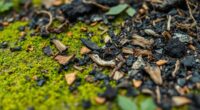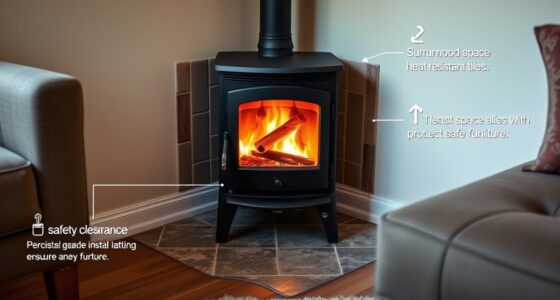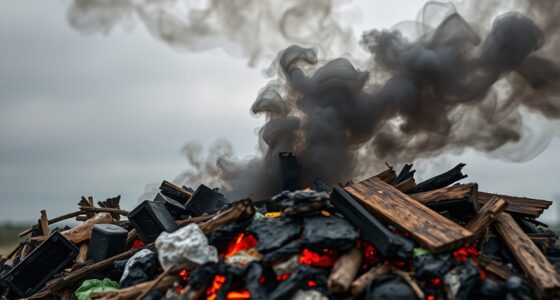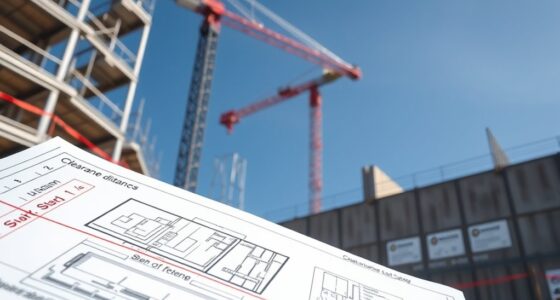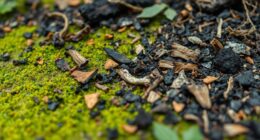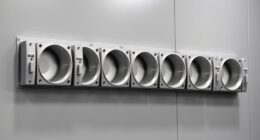To prevent chimney fires caused by creosote buildup, regularly inspect and clean your chimney, especially after the heating season begins. Use well-seasoned wood, avoid overloading your fireplace, and guarantee proper ventilation. Install a chimney cap to keep debris and animals out while improving draft. Watch for signs like smokeback or odors—any indication of trouble warrants prompt professional help. Continuing with safe practices will give you more tips to keep your home fire-safe and efficient.
Key Takeaways
- Regularly inspect and clean your chimney to detect and remove creosote buildup early.
- Burn only well-seasoned, dry wood to reduce creosote formation during combustion.
- Use a high-quality chimney cap to prevent debris, animals, and moisture from entering.
- Avoid overloading the fireplace and ensure proper ventilation for efficient burning.
- Recognize signs of creosote buildup or chimney trouble and seek professional maintenance promptly.

Have you ever wondered how to keep your home safe from fire? One of the most effective ways is by properly maintaining your chimney and fireplace. A essential step in this process is ensuring your chimney is equipped with a good chimney cap. Not only does a chimney cap keep out rain, debris, and animals, but it also plays a fundamental role in preventing dangerous creosote buildup. Creosote is a highly flammable substance that forms when wood burns incompletely, and if it accumulates inside your chimney, it can ignite and cause a chimney fire. Installing a chimney cap helps reduce creosote buildup by improving draft and preventing excess moisture from entering the chimney, which can accelerate creosote formation. Regularly inspecting and cleaning your chimney is essential because creosote buildup can become thick and sticky over time, increasing the risk of fire.
When you burn wood, especially if it’s not seasoned properly, you’re more likely to produce excess creosote. To minimize this, use well-dried, seasoned wood and avoid overloading your fireplace. Also, make sure your fireplace is operating efficiently; a well-maintained stove or fireplace burns cleaner and produces less creosote. But even with these precautions, creosote can still accumulate, which is why regular chimney inspections and professional cleanings are fundamental. During inspections, a technician can identify creosote buildup early before it reaches dangerous levels. They might use specialized brushes and vacuums to remove the deposits, reducing the risk of ignition. Additionally, using proper fuel can help minimize creosote formation, as burning dry, seasoned wood produces less residue. It’s also worth noting that a chimney cap can serve as an extra safeguard against sparks escaping and igniting nearby combustible materials. This simple addition can save your home from a devastating fire. Beyond installation, you should develop a routine for chimney maintenance, especially before and after the heating season. If you notice any signs of trouble—such as smoke backing into your home, unpleasant odors, or visible creosote streaks on the chimney’s interior—call a professional immediately. Ignoring these signs can lead to dangerous chimney fires or carbon monoxide leaks.
Frequently Asked Questions
How Often Should I Have My Chimney Professionally Inspected?
You should have your chimney professionally inspected at least once a year to guarantee proper chimney maintenance and fire safety tips. Regular inspections help identify creosote buildup and other hazards that could lead to chimney fires. If you use your fireplace frequently or notice any issues like smoke backing up, consider more frequent inspections. Staying proactive with chimney maintenance keeps your home safe and prevents costly repairs.
What Are the Signs of Creosote Buildup?
Creosote buildup often shows up as black, tar-like deposits inside your chimney, giving a shiny or flaky appearance. If you notice excessive soot, persistent odors, or increased chimney corrosion, these are signs of dangerous creosote accumulation. You might also see creosote dripping or staining around the chimney top. Regular inspections help catch these signs early, preventing chimney fires and minimizing damage caused by creosote and corrosion.
Can Certain Types of Wood Increase Fire Risk?
Yes, certain types of wood can increase fire risk. Hardwoods with high wood density burn longer and produce more creosote if they have high moisture content. Softwoods with low density ignite quickly and create more creosote when moist. To reduce fire hazards, always use well-seasoned, dry wood with low moisture content, regardless of the type. This minimizes creosote buildup and lowers the chances of chimney fires.
Are Chimney Caps Effective in Preventing Fires?
Chimney caps are highly effective in fire prevention techniques because they prevent debris, leaves, and animals from entering your chimney, reducing fire risks. They also keep sparks from escaping and igniting nearby materials. By installing a chimney cap, you considerably lower the chance of creosote buildup, which is a major fire hazard. Overall, a chimney cap enhances safety and helps you maintain a safer, more efficient fireplace or stove.
How Do Weather Conditions Affect Chimney Safety?
Weather impact considerably influences your chimney safety. Seasonal effects, like heavy rain or snow, can cause moisture buildup, leading to creosote accumulation or rust, which increases fire risk. Cold weather may cause condensation inside the chimney, promoting creosote formation. Hot, dry conditions can also dry out creosote, making it more combustible. Regular inspections and maintenance help you mitigate these weather-related risks, ensuring your chimney stays safe year-round.
Conclusion
Remember, a simple cleaning can prevent a devastating fire—sometimes, the smallest effort saves the biggest loss. It’s ironic how neglecting to clear creosote can lead to tragedy, yet a routine check can spark peace of mind. The coincidence is clear: your safety depends on consistent maintenance, just as a spark needs dry tinder. Stay vigilant, and you’ll find that prevention isn’t just about fire—it’s about protecting what matters most.


